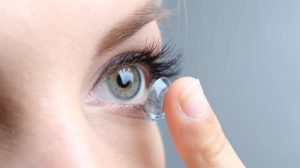What is Amblyopia?

Amblyopia (also called lazy eye) is poor vision in one eye. It develops in early childhood when the brain receives signals from both eyes that are too different.
The brain becomes confused and can not fully recognize the sight of the weaker eye. The brain prefers the image from the stronger eye and, over time, will only use the sight from that eye, while the vision of the weaker eye worsens.
It’s called lazy eye because the sight from the weaker eye is not being used by the brain, making the weaker eye even weaker over time.
Amblyopia starts to develop in early childhood, and it’s estimated that 3 to 6 out of 100 children have it. If left untreated, it can lead to permanent vision loss. Luckily early treatment works well.
What are the Symptoms of Amblyopia?
Unless your child has strabismus (cross-eyed) or a wandering eye, it is not obvious they have amblyopia. Your child might also not be aware that one eye is weaker than the other.
Signs that your child may have amblyopia are:
- Poor depth perception (your child may appear clumsy)
- Squinting
- Closing 1 eye
- Tilting his head
Most of the time, parents are not aware their child has amblyopia. Early treatment is crucial. That’s why kids need at least one thorough vision screening between the ages of 3 and 5.
What Causes Amblyopia?
Amblyopia occurs when the signals from the eyes to the brain are not similar. The brain will favor the best signal and start to ignore the signal from the weaker eye.
This can happen in the following cases:
- A significantly higher refractive error in one eye (vision in one eye is a lot weaker than the other eye’s vision)
- Strabismus or cross-eyedness. In this case, if one eye points in the wrong direction, it might drift in, out, up, or down.
- Childhood Cataracts. Babies can be born with cataracts or can develop cataracts later. The cloudiness of the lens blurs the vision.
- Ptosis or droopy eyelid. This can partially or entirely block the vision of one eye.
How is Amblyopia Treated?
The treatment of amblyopia starts with correcting the vision problem that’s causing the amblyopia.
So when a child is near or farsighted or has astigmatism, the eye doctor will prescribe eyeglasses or contacts. When cataracts cause a vision problem, surgery must be performed to remove cataracts.
Correcting the vision problem is not enough. When the vision problem is corrected, the brain has to be retrained in using the weaker eye. That way, the weaker eye will become stronger.
This can be achieved by wearing an eyepatch on the stronger eye for a few hours daily. The other option is to use Atropine drops once daily in the stronger eye. The Atropine drops cause temporary blurry vision and force the brain to use the weaker eye. Another option is to wear glasses with a lens that blurs the vision in the stronger eye.
This retraining of the brain usually takes a couple of months. After the vision in the weaker eye has strengthened, it will still be necessary to continue the eye patching temporarily during the next few years. Otherwise, the eye might weaken again.
Early treatment is essential and most effective when started before age 7. If left untreated, amblyopia may lead to permanent vision loss, so schedule your child’s first thorough vision screening between the ages of 3 and 5.
Every patient deserves top-quality eye care from us. European Eye Center focuses on providing Western-standard services and determining appropriate treatment plans to help patients restore their vision in a feel-like-home atmosphere.
We are happy to help if you have questions about amblyopia (lazy eye). Don’t hesitate to connect with us at appointment@europeaneyecenter.com.
Contact us today to schedule an eye care service!







